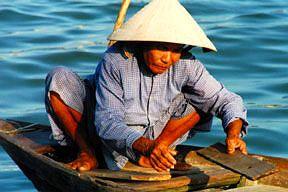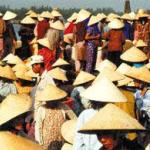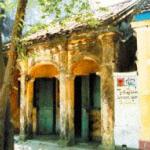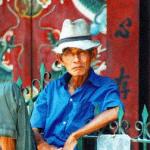Hoi An Interlude
Day One
Wind rushes through the open windows of our taxi. It smells of freshly turned earth and the not too distant South China Sea. It rattles the high pine needles and plays brittle melodies in the low, drooping eucalyptus leaves.
Cacti, with their fleshy, plate-like extremities, band together like parade spectators at the side of the road. Monet's haystacks linger in the background. Square, cement houses have been painted in fantastic shades of periwinkle and aqua. Beside these houses, inside three-walled, thatch-roofed shacks, rice is mashed through hand-propelled grinders. It is this labor that generates the earthy, boozy odor.
Although our flight from Saigon to Danang was brief, and this bone-rattling ride will soon be over, I devour the passing landscape as if it is a delicacy I have never tasted before, and that I might never have the chance to experience again. I have lived in Ho Chi Minh City, for almost a year, and its chaos has come to define Vietnam for me: traffic, pollution, crowds, sharp cawing voices, endless frustrations and never enough time or opportunity to escape from it.
Hoi An, our destination, was once overpopulated and commercial, like present-day Saigon. It was one of Southeast Asia's largest ports and even boasted a Dutch East Indies Trading Company. But by the eighteenth century its neighbor, Danang, took over as the area's main trading destination and Hoi An returned to its peaceful, backwater existence.
Our taxi leaves us at a simple, riverfront guesthouse, snug against the bridge on Phan Boi Chau Street. The back terrace overhangs the river. The wind shushes over the surface of the water, like the hem of a silk skirt trailing over a polished floor. In Saigon, exhaust tints the sky a mysterious gold; here, the air is clean. The sun is high and the sky is pale. The heat is unfiltered, but tempered by a loose wind off the river.
It is early in the afternoon. The fishing boats are out to sea, but a few women propel crude, flat timber crafts upriver. They stand, one at each end, with their feet planted wide to keep their balance, lazily thrusting bamboo poles into the current. Their faces are shaded, hidden by conical straw hats.
After a long, lazy nap, my friend and I head for the market which runs down the same side of the Thu Bon River as our hotel, trailing the length of the town. Tarps hang low between stalls to protect sellers and their goods from direct sunlight. It is not a place constructed for our ease and our backs are necessarily hunched.
Baskets overflow with saffron and the ground is covered in a sheer yellow dust, as if someone has shaken an abundant bouquet of spring flowers. We wait for the shouting to begin. "You, you! Hello, you! What your name? Where you from? You!"
Instead, pigs snuffle quietly, trussed inside barrel-shaped bamboo frames. They look bewildered, not only by their fate, but by life in general. One owner teasingly starts the bidding at "one dollar," but otherwise we are left alone, a little stunned at first that no one has accosted us with friendship in order to procure a free English lesson. In fact, when I stop to buy lentils, the women manning the stalls encourage my sad mutilation of their complicated, tonal language. They know enough English not to have to tolerate this, but they do not use it. In Saigon people often apologize for not speaking English, but here they graciously assert their right to be spoken to in their native tongue.
We are surrounded on all sides by goods and women. Young women with firm, high cheekbones. Crones with little black stubs behind their puckered lips. Women smoking, which is a rare sight in Vietnam. It is almost spooky, how few men there are to be seen. Some can be found minding shops on Tran Phu Street, but Hoi An's lifeblood, this market and its attached docks, is dominated by women.
At the Cafe des Amis, we are led up to the second story balcony by a young gentleman who appears to be no older than nine. We realize, though, that he is probably fourteen. Like many children in this country, his expression is world-weary and world-wise.
The sun sets, but the pale blue light in the sky remains. A ferry glides up to the docks, its roof laden with baskets and bicycles. Its bow is crowded with passengers squatting side by side, shoulder to shoulder. If we were not in the tropics, I'd think they were huddling together for warmth.
Inside the cafe a stereo plays gritty, sensuous New Orleans blues. There is a small side table covered with laminated reviews, praising the restaurant as one of the best in the country. Instead of a menu we are given a choice: vegetarian or seafood. The prix fixe is 35,000 dong, a little under three USD. The plates continue to arrive long after we are full. We roll our eyes at the surplus of shrimp and fish prepared with rice pancakes, papers and pastes.
My friend wanders downstairs to request more drink so we can stall for time while our appetites return. He finds our waiter in the kitchen, changed into a white dress shirt and bow tie in anticipation of the dinner crowd. Oil sizzles in a pan and the boy begins to chop vegetables; he is also our chef.
According to one source, there are 844 buildings of historical significance in Hoi An. Many of these cast their angular shadows into Tran Phu Street, a thin, winding path that runs out of town through the pink interior of a Japanese covered bridge, a relic of Japan's seventeenth century silk interests.
Some of these buildings sell themselves as museums and you must pay a fee to enter. Most of the others have been turned into shops. Not much has been altered both in and out of these structures since they were built in the nineteenth century. Hand-painted silk lanterns hang from dark, oily, timber beams. The weathered timber floors slope as if rolling over a gentle sea.
The majority of the shops offer custom tailored services or paintings. There is a distinct sunflower fabric that has been stitched into a spaghetti strap sundress and hangs in a front display in every tailor shop in town; and in almost all galleries there is some sort of whimsical depiction of Hoi An's coiling streets and sway-backed, tile roofs. Originality is so rare that I am hypnotized by the stuttering displays.
It's a strange commercial tactic that is evident in Saigon as well. If one person sells a particular item in one area, chances are everyone else in the vicinity will decide to sell the exact same thing. In Saigon, expatriates refer to these places not by their given names, but by their wares: Food Street, CD Street, Stereo Street, Antique Street, Stationery Street, etc.
This business practice discourages me at first, but after tramping the length of Tran Phu Street half a dozen times, I find myself admiring the flowered sundresses. I am drawn to the crude pastel townscapes with their charming old buildings. I am comforted by the familiarity of the merchandise here. I want one of those dresses. I want one of those paintings and I begin scouting for just the right one. I am in love with Hoi An and those two items will remind me of this amazing place forever.
Day Two
A hallway tunnels through the center of our hotel, threaded by morning sunlight. It is 6:30 a.m. My friend is at the market taking photographs and I wait for him on the lower terrace. I order coffee. It arrives black, and because there is nothing but sweet milk available, it remains black.
The fishing boats ride the current out to sea. Their ragged engines scratch the surface of the still water. (It won't be until our last day that one of the hotel workers shatters my romantic "fishing village" illusions by telling me that these picturesque boats are "no good for future." They use explosives and now, "There only small fish. No big fish. All die.")
When my friend returns, we decide to spend the day visiting nearby ceramic and wood-carving villages that we learned of last night from Mrs. Lan, a shopkeeper on Tran Phu Street. Mrs. Lan should work for the local tourism department. She had the opportunity to attend the university in Saigon, but returned to Hoi An as soon as she finished. "I will stay in Hoi An forever," she told me, "It is easy to be happy here."
Down on the docks there are so many women wearing conical hats that from a distance they appear to be one body covered in a roof of overlapping tiles. A teenager offers us the services of his boat, but we tell him that we already promised our business to another boy yesterday. The teenager becomes so excited that his voice cracks. He tells us that the other boy is his younger brother. Together, they lead us to the water's edge. We show them the names of the villages: Cam Kim and Cam Ha. Without haggling, we settle on a price. The three dollars an hour is just above what Mrs. Lan suggested and far below what we were willing to pay.
The brothers push off, and the older brother, with his floppy Jackson Five hat bobbing in the breeze, takes out a Vietnamese-English dictionary and launches the conversation. "Where are you from? I and my younger brother are not from Hoi An. I and my younger brother are from the country by the mountain. The people in I and my younger brother's country cut trees. There is no develop in I and my younger brother's country. I and my younger brother come to Hoi An to go school. I am going to be engineer. My younger brother is going to be English teacher. My younger brother is going back to I and my younger brother's country to teach."
Half an hour later we are no more than a stone's throw upriver from Hoi An. "How much longer to Cam Kim?" "Oh," says our leader, "Cam Kim very far. Cannot go Cam Kim. If my boat, we go, but not my boat. You understand? Not my boat. Cannot go. Very far. You come my house and eat."
The brothers are sweet, but our skin is turning red and we have little desire to sit in a swampy riverside shack exchanging our native expertise in English for one ready-made order of local color. We have our hearts set on ceramics and woodcarvings. We ask I and My Younger Brother to return to Hoi An, where I and My Friend rethink our strategy over wonton soup. Hoi An is famous for wonton soup.
After dousing one another in sunscreen, we return to the docks in search of a motorboat to ferry us out to those "very far" villages. Our afternoon captain is a middle-aged woman. She protects her body with long trousers, a long-sleeved shirt, a conical hat, and a scarf that hides her lower face, as if she is a virginal maiden or a camel trader from the Middle East. The bit of skin revealed is the color and texture of mineral rich earth. The only time we see more than just her eyes is when she lowers the scarf in order to wedge a burly, hand-rolled cigarette between her chapped lips. She is not disinterested in or excruciatingly curious about us, and if she speaks a single word of English, she does not make it known. She simply sits in the stern of her flat old boat, operating it by means of a splintery wooden throttle and a chain that runs from the crazed engine to a metal ring attached to her big toe.
The sun has faded all impurity from the colors that stain the river and its shores: a Georgia O'Keefe desert superimposed over watery tropics. Sand-colored fishing nets are strung up on bamboo poles over the dark, buried undercurrent of the shallow river. They sag like four-poster hammocks beneath the low sky. Between seven and ten p.m. the nets will be lowered into the water, but now, raised high in the sun, they shimmer as if someone has been using them to pan for silver.
We travel upriver. Our captain steers the boat around an outcrop of land and into a small tributary. When we finally nudge the shore next to a fenced-in yard where an army of men are building an already faded, already weather-beaten fishing boat, she indicates that we have reached the wood-carving village of Cam Kim. We cross a yard of trampled weeds where chickens scratch the stale dirt. We come to a narrow lane, grown up on both sides with moist vegetation. A sweet, purple iris-morning glory hybrid creeps through the leaves. Branches extend lazily overhead, casting artful, shadowy mosaics over the path of sunlight that spills down the lane.
We search for woodcarvers, but all we find is an old man chiseling cliche statues. A small collection of eagles that look as if they belong on U.S. coins gathers dust on a shelf in his shop.
When a group of children spots us wandering, they shriek and mob us as if we are long-awaited celebrities. They pay particularly eager attention to my friend's camera case. To humor them, he decides to take a few photos. He reaches for the clasp and they lose their patience, hands extended, palms flat, using the full force of their bodies to push one another out of the way. "Cay viet," they chant. Although we speak minimal Vietnamese, we know we are expected to pay a price for being "rich foreigners."
My friend protects his camera bag as best he can. He has the majority of the attention, but one little girl remains quietly at my side. "Cay viet," she whispers, using her finger to sketch in the palm of her hand. Her request is earnest and persistent.
My Vietnamese language teacher does her best to hide her frustration with my inability to memorize the names of even the simplest objects. Every week she asks me the word for table, and every week I say "I forget" in English, because I forget how to say "I forget" in Vietnamese. But miraculously, with the little girl at my side, I recall, "viet bi." Ballpoint pen. The children in this poor village, so poor that we can't even find it, don't want money. They want pens. (Back in the city, a friend will tell me that the children in the countryside still use chalk on broken sheets of slate to do their work in the classroom.) We distribute the two pens we have, as fairly as possible among the shoving, frenzied mass. I give mine to the persistent little girl. My friend organizes a foot race. The children don't understand a word of English, but they do know what he's doing. Fortunately, he is able to count to three in Vietnamese. When the winner receives her prize, everyone--except for a boy who tripped--seems to agree that this was a fair method. As my friend and I float away, the children huddle on the shore, waving solemnly. Already, they've pulled the pens apart to see how they work--their hands are covered in ink.
My friend, who is an avid souvenir collector, is disappointed at not finding any wood-carvers. We tell our captain that we're ready to try our luck at the ceramics village. Puzzled, she points to the town directly across the river from us. "Cam Ha?" we ask, hopefully. Even more puzzled, she responds, "Hoi An." "Hoi An?" "Hoi An." My friend and I stare at one another, incredulously. We have just spent almost two hours on hard benches under blistering sun to travel in a circle that led us to a village less than fifteen minutes directly across the river from Hoi An.
We have dinner in a cafe across the street from Mrs. Lan's shop. There are four tables inside the restaurant and two on the porch, although inside and outside are separated by no more than a pair of round, vertical beams.
All six tables are occupied by foreigners. But they aren't the exhausted, antisocial cluster usually found in small Asian towns: little groups angry to discover that they are not the first foreign face ever seen in these distant parts. Those of us here are obviously too happy to have found Hoi An to really care whether the presence of others will affect our own credibility as adventurers.
I consider a painting I saw on our way to dinner: a misty, out-of-perspective, aerial portrait of Hoi An. It was only twenty-five dollars; I am deciding whether I want it, and if so, where to start bargaining. The lanterns reflect off the oily, wood walls and our faces shine.
Day Three
We decide to check out Cua Dai Beach. The ride is an easy twenty minutes and bicycles can be rented for less than a dollar, but I fight traffic on a bicycle every day in Saigon. This is my holiday--I want a motorcycle. Naturally, we rent a Minsk. These dubiously made machines from Belarus are not pretty, but they do the trick on Vietnam's poorly maintained roads. The beach seems from another time and place. We are less than thirty miles from the China Beach of R&R war fame, but that is not what I am thinking of--it's more like Coney Island during the early twentieth century. At the end of the road there is a small area of packed sand populated by clusters of tables, lounge chairs and striped umbrellas. When we arrive, we are the only foreign faces in sight. There is a not too energetic shuffle over whose chairs we should lounge in, since every cluster is a privately owned business. We are informed that a table is free if we order food and drink. We order beer and fresh seafood: grilled fish and giant shrimp. Our waiter digs a cooler into the sand beside our chairs; it looks like a half-buried treasure chest. He brings a plate of moist, pink marine life for our inspection. We sniff and peer, as if appraising wine. We nod. When he returns, the flaky fish has been grilled to a white perfection.
While we eat, we watch a middle-aged couple dump a load of plastic tarps and long poles on the hard sand off to our left. They have a bucket of beverages, two stuffed straw bags, and a small, ceramic coal stove. They are obviously intending to set up a restaurant. The woman pounds two stakes through one end of the plastic tarp into the sand. The wind whips the other end over her head, ripping the stakes free. She tries again, while the man stuffs two poles into the shifting ground. Her stakes hold, but as soon as he constructs a crude lean-to by attaching one end of the tarp to one of his poles, the wind billows into the tarp, jerking the pole, and the poor man is nearly decapitated. They try again; he is almost beheaded again.
Day Four
We have arranged for a car to pick us up on our final day at noon. Suddenly, that morning, I panic. I realize that I must have the painting I saw two nights ago. I'll pay full price if I must. I race down Tran Phu Street, regretfully passing sunflower dresses since it's too late for me to have one custom-made before we leave. But when I arrive at the gallery, I am told they have all been sold. I mope back to the hotel. With little enthusiasm I glance into the shops as I pass. Maybe I will find something I like as well. I don't. And when we finally get to the airport, and are waiting to check in, I notice a foreign woman standing in line. I'd seen her ambling around Hoi An. She is carrying a plastic sack. Inside is a small cardboard tube. It is the kind of tube used by galleries in Hoi An to protect artwork. Somehow, I am certain that she has my painting in her bag. I inch closer, torturing myself. To make matters worse, wadded beside the tube is a sunflower dress, and the woman is just my size.
-
See also: Hoi An's Tam Tam Café by Steven Bailey; The Tran Family Home
 ThingsAsian
ThingsAsian



















